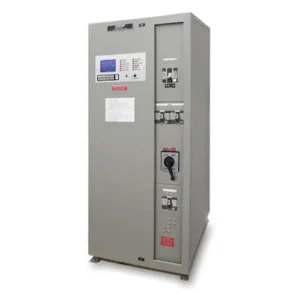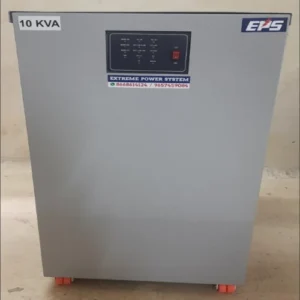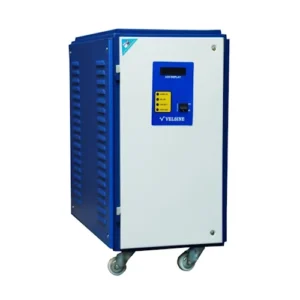Industrial Inverter
-
Enertech 415 V Ac 20kVA 240VDC Industrial Inverter
Brand EnertechInput Voltage 415 V ACWaveform Pure Sine Wave₹175,000.00 -
Luminous Lift Pro 6KVA Three Phase Inverters
Brand LuminousModel Lift Pro 6KVAPhase Three₹125,300.00Luminous Lift Pro 6KVA Three Phase Inverters
₹125,300.00 -
Digital Lift Inverters, 230 V Ac Single Phase
Input Voltage 230 V AC Single PhaseDisplay DigitalCapacity 500-1000 VA₹40,000.00 -
Industrial Inverter, 200KVA, Maxi
Model Name/Number MaxiPower Capacity 200KVAWaveform Pure Sine Wave₹3,000.00Industrial Inverter, 200KVA, Maxi
₹3,000.00 -
TechnoVision Industrial Inverter System, 5 Kva To 30 Kva
Brand TechnoVisionPower Capacity 5 KVA to 30 KVAWaveform Pure Sine Wave₹30,000.00 -
EPS 10 KVA Elevator Inverter
Power Capacity 10 KVAWaveform Pure Sine WaveOutput Frequency 50 Hz₹62,000.00EPS 10 KVA Elevator Inverter
₹62,000.00 -
Three Phase Lift Inverter, 50 kVA
Power Capacity 50 kVAInput Phase & Voltage 465 VOutput Phase & Voltage 400 V₹32,000.00Three Phase Lift Inverter, 50 kVA
₹32,000.00 -
Pure Sine Wave 6 Phase Sinewave Inverter Lift Backup System
Capacity 6 KVA To 120 KVABrand MakvoltWaveform Pure Sine Wave₹60,000.00
Industrial Inverters: The Comprehensive Guide
In the world of industrial machinery, efficiency and reliability are paramount. One of the critical components that help achieve these goals is the industrial inverter. These devices play a pivotal role in converting direct current (DC) to alternating current (AC), enabling the smooth operation of various electrical systems and machinery. This comprehensive guide will delve into what industrial inverters are, their types, benefits, features, and factors to consider when purchasing one. Additionally, we will address common questions in our FAQ section to ensure you have all the information needed to make an informed decision for your e-commerce business.
What is an Industrial Inverter?
An industrial inverter is an electrical device that converts DC power into AC power. These inverters are essential in various industrial applications, including manufacturing, renewable energy systems, and HVAC (heating, ventilation, and air conditioning) systems. By converting power, industrial inverters help run electric motors, pumps, and other equipment that require AC voltage.
Key Features of Industrial Inverters
- Power Conversion: Industrial inverters are designed to efficiently convert DC power to AC power, typically with adjustable frequency and voltage output.
- High Efficiency: Many modern inverters boast high efficiency ratings, often above 95%, reducing energy loss during the conversion process.
- Control Systems: Advanced control systems allow for precise management of output voltage and frequency, enhancing the performance of connected equipment.
- Durability: Industrial inverters are built to withstand harsh environments, featuring rugged construction that can endure temperature fluctuations, dust, and moisture.
- Versatility: These inverters can handle various applications, from powering motors in manufacturing plants to supporting renewable energy systems like solar power.
- Safety Features: Most industrial inverters come with built-in safety features, including over-voltage protection, over-current protection, and thermal shutdown to prevent damage to the unit and connected equipment.
Types of Industrial Inverters
When selecting an industrial inverter, it’s essential to understand the different types available, each suited for specific applications:
1. String Inverters
String inverters are commonly used in solar power systems. They convert DC power from solar panels into AC power for use in homes and businesses. These inverters are efficient and cost-effective, making them a popular choice for large-scale solar installations.
2. Central Inverters
Central inverters are larger units that manage multiple strings of solar panels. They are typically used in utility-scale solar power plants, providing high efficiency and reliability for large installations.
3. Microinverters
Microinverters are smaller units installed on each solar panel. They convert DC to AC power at the panel level, improving overall system performance and allowing for better energy harvest from partially shaded panels.
4. Frequency Inverters (VFDs)
Variable Frequency Drives (VFDs) are a type of industrial inverter that controls the speed of electric motors by varying the frequency of the AC power supplied. VFDs are widely used in applications like pumps, fans, and conveyors.
5. Grid-Tie Inverters
Grid-tie inverters connect solar power systems to the electrical grid. They allow for the export of excess power generated by solar panels back to the grid, enabling users to earn credits on their electricity bills.
6. Off-Grid Inverters
Off-grid inverters are used in systems that are not connected to the electrical grid, such as remote locations powered by renewable energy sources. These inverters manage battery storage and power distribution to ensure a steady supply of electricity.
Benefits of Using Industrial Inverters
Investing in industrial inverters can provide numerous advantages for businesses and industries, including:
1. Energy Efficiency
Industrial inverters can significantly reduce energy consumption by optimizing the performance of motors and other electrical equipment. This efficiency leads to lower operational costs and reduced environmental impact.
2. Improved Equipment Longevity
By providing precise control over power supply and reducing mechanical stress on equipment, industrial inverters can enhance the lifespan of motors and other machinery. This durability translates to fewer maintenance costs and downtime.
3. Enhanced Performance
With the ability to adjust voltage and frequency, industrial inverters enable equipment to operate at optimal performance levels. This flexibility can lead to improved productivity and output quality.
4. Renewable Energy Integration
For businesses utilizing renewable energy sources like solar or wind, industrial inverters play a crucial role in converting and managing power, making it easier to integrate these systems into existing operations.
5. Scalability
Industrial inverters are often designed to accommodate growing businesses. They can be easily scaled up or down based on power requirements, making them a flexible solution for changing needs.
6. Safety and Protection
With built-in safety features, industrial inverters protect both the inverter and connected equipment from electrical faults, overloading, and overheating, ensuring a safe working environment.
Factors to Consider When Buying an Industrial Inverter
When purchasing an industrial inverter, it’s important to consider several factors to ensure you select the right model for your needs:
1. Power Rating
Determine the power requirements of your equipment and choose an inverter with a suitable power rating. Consider peak power demands and continuous power needs to ensure the inverter can handle your applications.
2. Type of Inverter
Select the type of inverter that best fits your application. Whether you need a string inverter for solar power or a variable frequency drive for motor control, choosing the right type is crucial.
3. Efficiency Rating
Look for inverters with high efficiency ratings to minimize energy loss during power conversion. Higher efficiency can lead to significant cost savings over time.
4. Control Features
Evaluate the control features of the inverter, including programmable settings, remote monitoring, and communication capabilities. Advanced control features can enhance operational efficiency and ease of use.
5. Environmental Conditions
Consider the environment where the inverter will be installed. Ensure it has a suitable IP (Ingress Protection) rating to withstand dust, moisture, and temperature fluctuations.
6. Safety Standards
Ensure the inverter meets relevant safety standards and certifications, such as UL, CE, or ISO, to guarantee its reliability and safety in industrial applications.
7. Warranty and Support
Check the warranty offered by the manufacturer and the availability of customer support. A good warranty can provide peace of mind and protect your investment.
8. Cost
While it’s essential to stay within budget, prioritize quality and features over the lowest price. A higher-quality inverter may offer better performance and longevity, ultimately saving you money in the long run.
Frequently Asked Questions (FAQs)
1. What is the main purpose of an industrial inverter?
The primary purpose of an industrial inverter is to convert direct current (DC) power into alternating current (AC) power. This conversion allows various industrial equipment and machinery to operate efficiently.
2. How do I determine the right size of an industrial inverter?
To determine the right size, consider the power requirements of your equipment, including peak and continuous power needs. It’s advisable to choose an inverter with a power rating that exceeds your maximum demand for optimal performance.
3. Can an industrial inverter be used for renewable energy systems?
Yes, industrial inverters are commonly used in renewable energy systems, such as solar and wind. They convert the DC power generated by these sources into AC power for use in homes, businesses, or to feed into the grid.
4. What are the advantages of using a variable frequency drive (VFD)?
VFDs provide precise control over motor speed and torque, leading to increased efficiency, reduced energy consumption, and extended equipment lifespan. They also allow for smooth starts and stops, minimizing mechanical stress.
5. Are industrial inverters easy to install?
While many industrial inverters come with user-friendly designs, installation may require professional assistance, especially for larger units or complex systems. Always refer to the manufacturer’s guidelines for installation.
6. What safety features should I look for in an industrial inverter?
Look for features such as over-voltage protection, over-current protection, thermal shutdown, and short-circuit protection. These features help safeguard both the inverter and connected equipment.
7. How long do industrial inverters typically last?
With proper care and maintenance, industrial inverters can last 10 to 15 years or longer. Regular servicing and monitoring can extend their lifespan and performance.
8. Can I use an industrial inverter for home applications?
While industrial inverters are designed for commercial and industrial use, smaller models can be used for home applications, particularly in renewable energy systems. However, ensure the inverter meets the specific requirements of your home electrical system.
9. What is the difference between grid-tie and off-grid inverters?
Grid-tie inverters are designed to connect to the electrical grid, allowing for excess energy to be fed back into the grid. Off-grid inverters operate independently of the grid and typically manage battery storage and power distribution.
10. Where can I buy industrial inverters?
Industrial inverters can be purchased from various sources, including e-commerce websites, industrial supply stores, and specialized electrical equipment distributors. Always choose reputable suppliers to ensure product quality and support.
Conclusion
Industrial inverters are essential components in modern industrial applications, offering efficiency, reliability, and versatility. By understanding the different types of inverters, their benefits, and key considerations for purchasing, you can make informed decisions.
Investing in a high-quality industrial inverter will enhance the performance of your equipment, reduce energy costs, and support your operational goals. Whether you’re in manufacturing, renewable energy, or HVAC, the right industrial inverter can significantly impact your business’s efficiency and productivity.








